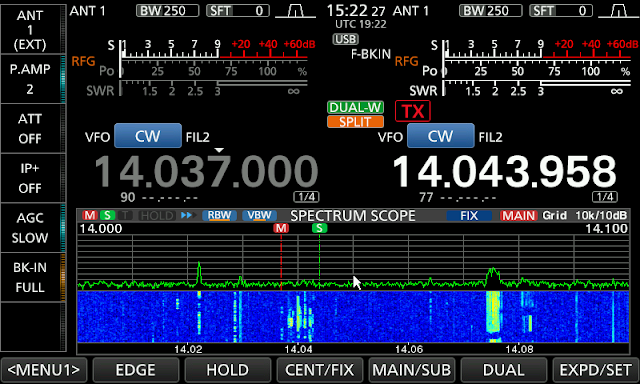 The art of working split to contact a DXpedition.
The art of working split to contact a DXpedition.
 |
| Contacting 7P8RU |
Yesterday afternoon while on 20m I noticed a large gathering around 14.040. After a little investigating, I found it to be the 7P8RU DXpedition from Lesotho located in South Africa. The team were excellent CW operators and this made for a very organized pileup. As I listened to find out how they were working the pileup I found that as always operators trying to contact 7P8RU on their calling frequency. With most if not all DXpeditions they operate split, meaning they call CQ on one frequency and listen on another. Their listening frequency can vary from 1kHz to 5kHz span.
I find it best to listen to the DX station and also those trying to contact the DX station. This is done to learn how the DX station is working "the pileup"..... those who are trying to make contact. Most if not always the DX station has a pattern on how they contact calling stations. Other times they indicate specific regions they only want to contact. It's best to listen first and find out the DX's rhythm, and also if they are working a region of the world that you are not in. This avoids you calling not getting answered and the DX station wondering why you're not listening to instructions. This just brings about frustrations at both ends.
Now down to the nitty-gritty of making contact! Once you have listened and found out the DX rhythm and that he is working stations in your part of the world, it's time to jump in the fray. But wait, how does one listen to both the DXpedition and perspective contact stations, who are 1-4 kHz away? This is where rigs with 2 independent receivers come in very handy. The 2 independent receivers allows you to hear VFO A and VFO B at the same time or the DX and those who are trying to contact them. In my case I use headphones with VFO A in my left ear and VFO B in my right ear.
They do say that a picture is worth a thousand words....and with DXpeditions this is also very true. It's great to hear both sides but adding a visual representation is fantastic! This is done with a radio that has a spectrum scope. Now you are able to hear and see each station the DX is working. As the DX either moves up or down the band, you can fit your signal in the pathway and toss out your call and see if you are heard.
The Icom 7610 has all the above-mentioned bells and whistles, as do many other HF and SDR rigs. The picture above is a screenshot of my 7610 setup to work 7P8RU. I have turned on "Dual watch" this allows me to hear both VFO A (main) and B (sub) Split has been turned on, so I transmit on VFO B and not on top of 7P8RU on VFO A.
On the spectrum scope, the red M is the main VFO A, and it is set on 7P8RU's calling frequency. The crowd of signals to the right (between M and S) are those calling the DXpedition station. The green "S" is my sub VFO marker and tells me where my transmit signal will be.
One nice thing about the scope, once 7P8RU has contacted a station, most times you can see this station visually answering the DX station. By watching this interaction you get an idea of how the DX station is working the pileup. The above picture shows the scope giving a band slice of 100 kHz and you can see t FT8 to the far right and toward the bottom of the band other CW signals. When working the DXpedition I have the scope set to a narrow slice of the band, so I can get a better picture of the pileup and who is being worked by the DX.
It's great fun to work these stations when you can hear them, and it gives you a good workout on learning your radio and what it can do. In my case 7P8RU was contacted and is in the log!













Good description, and I still remember being so amazed that my first DX split contact (to an S0) actually worked. You’re quite right about the rhythm, even when not working split I find callers and DXers get into a regular pattern that can be almost choir-like in its chant. And I agree, there’s always somebody who doesn’t listen and calls on the station’s frequency.
What I do find helps a lot–and not every rare DXer does this–is to call by numbers as that definitely cuts the competition down. One of the oddest ways of calling I ever saw (way back when a KL200 station was active) was calling 3 stations whose calls ended in “A”, 3 in “B” and so on to “Z”. It actually worked pretty darn well. But even when a specific area/continent whatever is used somebody will jump the line. The point, as you well say here Mike, is to listen before replying.
Good morning Richard, thanks for taking the time to read the post and leave a comment. Yes, for the DX station to put parameters around whom he will answer sure would help with the pileup. Richard, I read your QRZ bio, and it seems you have had a very rewarding career…….and still do. All the best with your flying hobby as well as ham radio.
73,
Mike
VE9KK